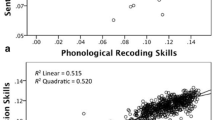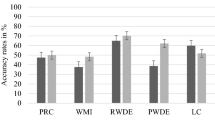Abstract
While prior knowledge of a passage topic is known to facilitate comprehension, little is known about how it affects word identification. We examined oral reading errors in good and poor readers when reading a passage where they either had prior knowledge of the passage topic or did not. Children who had prior knowledge of the topic were matched on decoding skill to children who did not know the topic so that the groups differed only on knowledge of the passage topic. Prior knowledge of the passage topic was found to significantly increase fluency and reduce reading errors, especially errors based on graphic information, in poor readers. Two possible mechanisms of how prior knowledge might operate to facilitate word identification were evaluated using the pattern of error types, as was the relationship of errors to comprehension. Implications of knowledge effects for assessment and educational policy are discussed.


Similar content being viewed by others
Notes
Exceptions to the above rules concern substitutions for 2-letter words. Because these words are so short, applying the same rules resulted in many substitutions being classified as graphically similar when they only shared one letter and did not really seem to be retaining much graphic similarity (e.g. the substitution of that for an). In the case of 2-letter words, only substitutions that share the initial letter of the target word were counted as graphically similar.
References
Beebe, M. J. (1980). The effect of different types of substitution miscues on reading. Reading Research Quarterly, 3, 324–336.
Bransford, J., & Johnson, M. (1972). Contextual prerequisites for understanding: Some investigations of comprehension and recall. Journal of Verbal Learning & Verbal Behavior, 11(6), 717–726.
Chard, D., Vaughn, S., & Tyler, B. (2002). A synthesis of research on effective interventions for building reading fluency with elementary students with learning disabilities. Journal of Learning Disabilities, 35(5), 386–406.
Duke, N. K., Pressley, M., & Hilden, K. (2004). Difficulties with reading comprehension. In C. A. Stone, E. R. Silliman, B. J. Ehren, & K. Apel (Eds.), Handbook of language and literacy: Development and Disorders (pp. 501–520). New York: Guilford Press.
Dunn, L. M., & Markwardt, F. C. (1970). Examiner’s manual: Peabody individual achievement test. Circle Pines, MN: American Guidance Service.
Erickson, T., & Mattson, M. (1981). From words to meaning: A semantic illusion. Journal of Verbal Learning & Verbal Behavior, 20(5), 540–551.
Fuchs, L., Fuchs, D., & Compton, D. (2004). Monitoring early reading development in first grade: Word identification fluency versus nonsense word fluency. Exceptional Children, 71(1), 7–21.
Goodman, K. S. (1969). Analysis of oral reading miscues: Applied psycholinguistics. Reading Research Quarterly, 5, 9–30.
Goodman, K., & Goodman, Y. (1977). Learning about psycholinguistic processes by analyzing oral reading. Harvard Educational Review, 47(3), 317–333.
Gough, P. (1983). Context, form, and interaction. In K. Rayner (Ed.), Eye movements in reading (pp. 203–211). New York: Academic Press.
Hirsch, E. D. (2006). Building knowledge: The case for bringing content into the language arts block and for a knowledge-rich curriculum core for all children. American Educator, 30(1). Retrieved from http://www.aft.org/pubs-reports/american_educator.htm.
Johnston, P. (1984). Prior knowledge and reading comprehension test bias. Reading Research Quarterly, 19, 219–239.
Kamhi, A. (2007). Knowledge deficits: The true crisis in education. The ASHA Leader, 12, 28–29.
Keenan, J. M., & Betjemann, R. S. (2007). Comprehension of single words: The role of semantics in reading and reading disability. In E. Grigorenko & A. Naples (Eds.), Single word reading (pp. 191–210). London: Taylor & Francis.
Keenan, J. M., Betjemann, R. S., Wadsworth, S. J., DeFries, J. C., & Olson, R. K. (2006). Genetic and environmental influences on reading and listening comprehension. Journal of Research in Reading, 29, 79–91.
LaBerge, D., & Samuels, S. (1974). Toward a theory of automatic information processing in reading. Cognitive Psychology, 6(2), 293–323.
Landauer, T. K. (2002). Applications of latent semantic analysis. In W. D. Gray & C. D. Schunn (Eds.), Proceedings of the twenty-fourth annual conference of the cognitive science society. London: Psychology Press.
Leslie, L. (1980). The use of graphic and contextual information by average and below-average readers. Journal of Reading Behavior, 12, 139–149.
Leslie, L., & Caldwell, J. (2001). Qualitative reading inventory (3rd ed.). New York: Addison Wesley Longman, Inc.
Malik, A. A. (1990). A psycholinguistic analysis of the reading behavior of EFL-proficient readers using culturally familiar and culturally nonfamiliar expository tests. American Educational Research Journal, 27, 205–223.
McNamara, D. S., & Kintsch, W. (1996). Learning from texts: Effects of prior knowledge and text coherence. Discourse Processes, 22, 247–282.
Miller, A. C., & Keenan, J. M. (2009). How word decoding skill impacts text memory: The centrality deficit and how domain knowledge can compensate. Annals of Dyslexia, 59, 99–113.
Murphy, S. (1999). The validity and reliability of miscue analysis. In A. M. Marek & C. Edelsky (Eds.), Reflections and connections: Essays in honor of Kenneth S. Goodman’s influence on language education (pp. 95–122). Cresskill, NJ: Hampton Press.
Nation, K., & Cocksey, J. (2009). Beginning readers activate semantics from sub-word orthography. Cognition, 110, 273–278.
Nation, K., & Snowling, M. (1998). Individual differences in contextual facilitation: Evidence from dyslexia and poor reading comprehension. Child Development, 69(4), 996–1011.
National Institute of Child Health and Human Development. (2000). Report of the National Reading Panel. Teaching children to read: An evidence-based assessment of the scientific research literature on reading and its implications for reading instruction (NIH Publication No. 00-4769). Washington, DC: U.S. Government Printing Office.
National institute of Child Health, Human Development. (2005). A day in third grade: A large-scale study of classroom quality and teacher and student behavior. The Elementary School Journal, 105(3), 305–323.
Nicholson, T., & Tan, A. (1999). Word identification processes. In G. B. Thompson & T. Nicholson (Eds.), Learning to read: Beyond phonics and whole language (pp. 150–173). New York: Teachers College Press.
Olson, R. K. (2006). Genes, environment, and dyslexia: The 2005 Norman Geschwind memorial lecture. Annals of Dyslexia, 56, 205–238.
Olson, R. K., Forsberg, H., Wise, B., & Rack, J. (1994). Measurement of word recognition, orthographic, and phonological skills. In G. R. Lyon (Ed.), Frames of reference for the assessment of learning disabilities: New views on measurement issues (pp. 243–277). Baltimore: Paul H. Brookes Publishing Co.
Pearson, P., & Hamm, D. (2005). The assessment of reading comprehension: A review of practices-past, present, and future. In S. G. Paris & S. A. Stahl (Eds.), Children’s reading comprehension and assessment (pp. 13–69). Mahwah, NJ, USA: Lawrence Erlbaum Associates Publishers.
Perfetti, C. A. (1985). Reading ability. Oxford: Oxford University Press.
Perfetti, C., Goldman, S., & Hogaboam, T. (1979). Reading skill and the identification of words in discourse context. Memory & Cognition, 7(4), 273–282.
Pinnell, G. S., Pikulski, J. J., Wixson, K. K., Campbell, J. R., Gough, P. B., & Beatty, A. S. (1995). Listening to children read aloud. Washington, DC: US Department of Education, Office of Educational Research and Improvement.
Plaut, D., McClelland, J., Seidenberg, M., & Patterson, K. (1996). Understanding normal and impaired word reading: Computational principles in quasi-regular domains. Psychological Review, 103(1), 56–115.
Priebe, S. J., & Keenan, J. (2009). Automated methods of assessing oral reading accuracy. Poster presented at the annual meeting of the Society for the Scientific Study of Reading, Boston, MA.
Rawson, K. A., & Van Overschelde, J. P. (2008). How does knowledge promote memory? The distinctiveness theory of skilled memory. Journal of Memory and Language, 58, 646–668.
Recht, D. R., & Leslie, L. (1988). Effect of prior knowledge on good and poor readers’ memory of text. Journal of Educational Psychology, 80, 16–20.
Reder, L., & Kusbit, G. (1991). Locus of the Moses illusion: Imperfect encoding, retrieval, or match? Journal of Memory and Language, 30(4), 385–406.
Rodd, J. (2004). When do leotards get their spots? Semantic activation of lexical neighbors in visual word recognition. Psychonomic Bulletin & Review, 11(3), 434–439.
Sadoski, M., Carey, R. F., & Page, W. D. (1999). Empirical evidence for the validity and reliability of miscue analysis as a measure of reading comprehension. In A. M. Marek & C. Edelsky (Eds.), Reflections and connections: Essays in honor of Kenneth S. Goodman’s influence on language education (pp. 123–144). Cresskill, NJ: Hampton Press.
Spilich, G., Vesonder, G., Chiesi, H., & Voss, J. (1979). Text processing of domain-related information for individuals with high and low domain knowledge. Journal of Verbal Learning & Verbal Behavior, 18(3), 275–290.
Stahl, S., & Heubach, K. (2006). Fluency-oriented reading instruction. In K. A. D. Stahl & M. C. McKenna (Eds.), Reading research at work: Foundations of effective practice (pp. 177–204). New York, NY, USA: Guilford Press.
Stanovich, K. (1984). The interactive-compensatory model of reading: A confluence of developmental, experimental, and educational psychology. RASE: Remedial & Special Education, 5(3), 11–19.
Taft, M., & Leslie, L. (1985). The effects of prior knowledge and oral reading accuracy on miscues and comprehension. Journal of Reading Behavior, 17(2), 163–179.
Tan, A., & Nicholson, T. (1997). Flashcards revisited: Training poor readers to read words faster improves their comprehension of text. Journal of Educational Psychology, 89, 276–288.
Tulving, E., & Gold, C. (1963). Stimulus information and contextual information as determinants of tachistoscopic recognition of words. Journal of Experimental Psychology, 66(4), 319–327.
Tunmer, W. E., & Chapman, J. W. (2004). The use of context in learning to read. In P. Bryant & T. Nuñes (Eds.), Handbook of children’s literacy (pp. 199–212). Dordrecht, the Netherlands: Kluwer.
Wechsler, D. (1991). Manual for the Wechsler Intelligence Scale for children (3rd ed.). San Antonio, TX: The Psychological Corporation.
West, R., & Stanovich, K. (1978). Automatic contextual facilitation in readers of three ages. Child Development, 49(3), 717–727.
Woodcock, R. W., McGrew, K. S., & Mather, N. (2001). Examiner’s manual. Woodcock-Johnson III Tests of Achievement.. Itasca, IL: Riverside Publishing.
Acknowledgments
This research was supported by a grant from NIH HD27802 to the Colorado Learning Disabilities Center, for which J. Keenan is a co-PI. These data were presented at the 2008 and 2009 meetings of the Society for the Scientific Study of Reading. We thank Richard K. Olson, Rebecca Betjemann, Laura Roth, Chelsea Meenan, and Anh Hua for discussions of the data, all the participants and their families, and all the testers and scorers.
Author information
Authors and Affiliations
Corresponding author
Rights and permissions
About this article
Cite this article
Priebe, S.J., Keenan, J.M. & Miller, A.C. How prior knowledge affects word identification and comprehension. Read Writ 25, 131–149 (2012). https://doi.org/10.1007/s11145-010-9260-0
Published:
Issue Date:
DOI: https://doi.org/10.1007/s11145-010-9260-0




